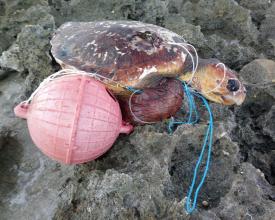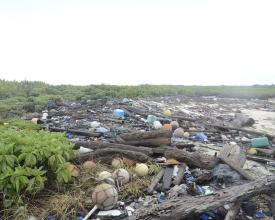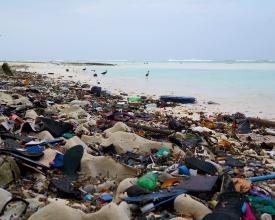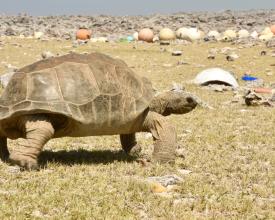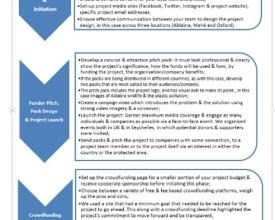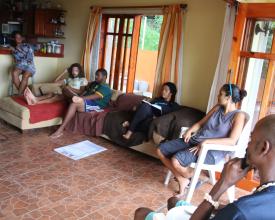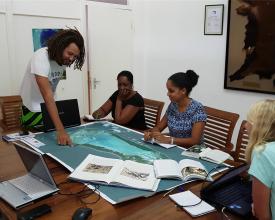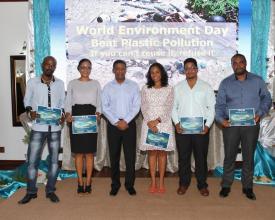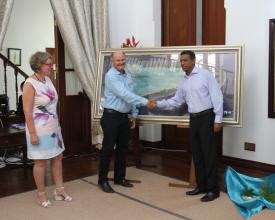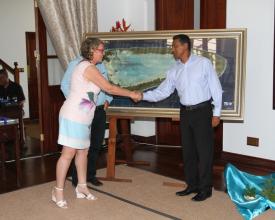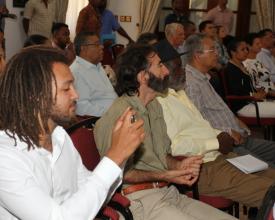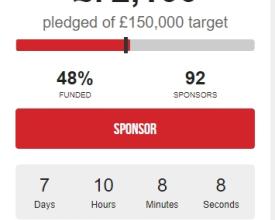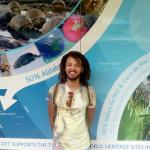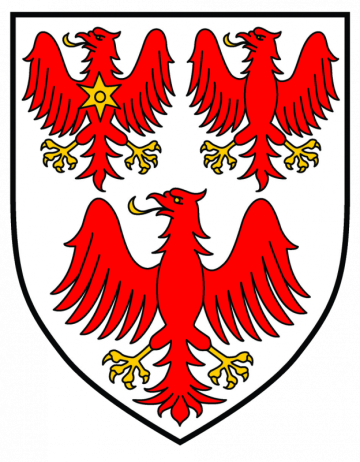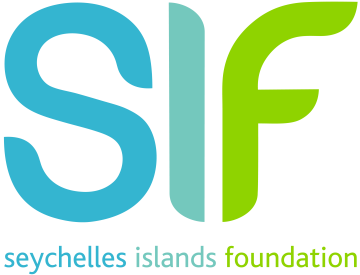
Funding the Aldabra Clean Up Project through Corporate sponsorship and Crowdfunding.
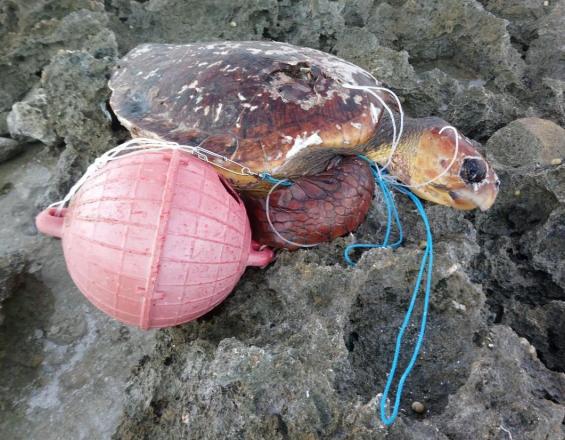
Plastic production has risen from 1.7 million tons in 1954 to 335 million tons in 2016. Much of this plastic has been carried by currents and wind throughout the world’s oceans. The end-point for much plastic is remote islands, such as the iconic Aldabra Atoll World Heritage Site. Vast amounts of plastic has been accumulating along the Aldabra’s shores. This impacts the island’s endemic and endangered fauna and demands urgent action. The Seychelles Islands Foundation (SIF), who manage Aldabra, in collaboration with the Queen’s College, Oxford University created the Aldabra Clean Up Project (ACUP). ACUP includes an expedition to clear plastic pollution from Aldabra. However, ACUP’s costs of exceeded SIF’s usual means of finance. Thus, outside the box thinking was needed to finance ACUP. This involved seeking funds through corporate sponsorship & crowdfunding, in Seychelles & the UK.
Context
Challenges addressed
Our solution addresses the challenge that many conservation organisations face; the necessity to achieve multiple conservation aims with limited funding. Whilst periodic funding is available, it is extremely competitive and comes with specific themes so that a project such as this may wait years to be eligible. By raising funds through alternative means, we can inform and engage local to gobal businesses of the impacts of marine plastic pollution on international sites of importance like Aldabra. The main challenge in creating this solution has been showing companies how and why financially supporting ACUP will benefit their own aims. For example cruise ships that visit Aldabra with high end tourism have an interest in not only ensuring Aldabra retains its pristineness, but also to show their clients that they actively assist the sites they visit. For other companies the inclusion of specific media commitments (project documentary & news articles) ensured their interests were met.
Location
Process
Summary of the process
The step by step chart that follows shows interrelationship between our blocks, but it is a simplification and in actuality such activities occur concurrently. The relationship between corporate sponsorship, crowdfunding and awareness raising is ultimately a virtuous cycle, but hard to show. Sponsorship opportunities in our pitch packs married raising awareness and environmental action with brand promotion. Thus, a strong social media presence, a solid website, good media coverage built public support and developed trust between ACUP and funders. Rewards that grew the more that was donated also motivated both individuals and corporations. Crowdfunding was inspired by corporate sponsorship, thus maximizing these funds while crowdfunding helps. With many facets in different places and strict deadlines it is vital to time manage and communicate clearly this mitigates distrust and misunderstanding between team members and funders. Having dedicated people communicate changes and results ensures eventualities are dealt swiftly and appropriately. Potential funders will have questions it’s key that those who manage social media pages can readily answer questions that relate to the project’s modalities, background, aims and practicalities.
Building Blocks
Project Design & Initiation
Before beginning to approach potential funders it was necessarily to carefully plan and design the project and anticipate all the information that funders would wish to know. This includes the project aims and outputs, the team involved, the logistical plan and the budget. It is also important to clearly think about how the project will have a lasting legacy beyond the clean-up expedition. This should be developed into a full written project proposal.
Following completion of the project design it is necessary to set-up project media sites, this also required developing a project logo, title and tag line. We also set-up specific project email addresses. The media sites (Facebook, Twitter, Instagram & project website) all required initial content and therefore a photo library was compiled and content text established. Before launching the project we also completed team recruitment (12 team volunteers in total) and allocated specific team roles for the duration of the project, for example, social media officer, outreach officer, science officer. With this now in place it was possible to plan a fundraising strategy.
Enabling factors
The project design required high levels of communication between the team In Oxford, The Seychelles Islands Foundation and the staff on Aldabra Atoll. This was to ensure the project fulfilled the overall aims and was financially and logistically feasible.
Lesson learned
Having multiple persons working on the project development is beneficial but to ensure cohesion of ideas it is necessary to have regular meetings and to review the project development at each stage thus reducing the likelihood that key considerations will be missed.
Funder Pitch Pack Design & Project Launch
It is necessary to develop a strong, concise and attractive pitch pack, which is professional and clearly shows the project’s importance and budget. It is extremely important to make a clear pitch on how, by funding the project, the organisation or company will benefit. For example, for X amount of money the funder logo will be used on project t-shirts and the funder will be mentioned in all media coverage. The pitch pack should include the project logo, and use visual aids to bring the point across. In this case we used images of Aldabra, it’s wildlife and the impact of the plastic pollution. Since we were distributing these packs in the UK and Seychelles it was vital to create each pack with the local context in mind, whether it was currency conversions or the use of particular quotes from recognisable figures. Alongside the pitch pack we created a campaign video which introduces the problem and the solution using strong imagery and a voiceover. With these steps completed, we could then plan the project launch. The aim of the launch was to garner a maximum amount of media coverage and engage as many individuals and companies as possible via a face-to-face event. We therefore organised events both in UK and in Seychelles, in which potential donors and supporters were invited.
Enabling factors
Team members skilled in visual design were key to ensure the pitch-pack was professional. The campaign video required basic video-editing skills, footage of the site and impact of plastic pollution. Advice on the pack’s design and how to approach companies from fundraising professionals was useful. ACUP’s launches took place in prominent locations, the Royal Society of London’s headquarters and the Seychelles State House. SIF’s Patron, Mr Danny Faure, President of Seychelles gave a video speech making ACUP as a project of national significance.
Lesson learned
We found that the most likely success in pitching our project was to companies with some connection, either to a team member of the project or to the project itself via an interest in either Seychelles or Aldabra specifically. It is important to take time in ensuring that if you are emailing companies that you email the appropriate person to deal with your request. It is also a very good idea to make as many face-to-face connections as possible during the launch event and answer queries about the project to ensure there are no misunderstandings regarding project objectives and outputs. It is also a lot easier to gain the attention of funders if you already have some sponsorship and even better if you have a media partner for the project e.g. a local or international news agency.
Crowdfunding
Crowdfunding is a relatively new way of funding projects, the goal being to inspire individuals to want to help you achieve the project goals by donating to the project budget. There are several online crowdfunding platforms that work in different ways, some of which require a fee whilst others are free. We used a site that requires us to meet a set amount of our budget before funds were extracted from donors, if we didn’t reach that amount then the project would not go ahead. The crowdfunding site was easy to set up but requires you to write project details into sections. This should be easy because of already writing the project proposals and pitch packs. We were also able to embed the campaign video into this site. Once the site was set-up we shared it on all our social media sites and through our personal networks.
Enabling factors
It is extremely straightforward to achieve this step, once the necessary research and preparations are in place. It is a matter of 'just do it'. Once the crowdfunding begins, and gains momentum, it creeaetes a sense of excitement and energy among project team members and contributors alike, as we watch targets being met and the portfolio of supporters grow. Access to the totals and ability to track contributions is an important enabling factor.
Lesson learned
The important lesson we learnt during the crowdfunding stage is that it is better to set up the crowdfunding page for a smaller portion of your project budget and therefore better to wait to see if your receive any cooperate sponsors before initiating this phase. It was also useful that SIF had committed £20,000 pounds to the project. This encouraged public and corporate sponsorship as it was used to match the first £20,000 that was raised. People are also more likely to sponsor a project target that looks achievable especially bearing in mind these will be smaller donations. The crowdfunding page must also portray the project clearly and appeal to a wide variety of people. It is therefore important to set up the reward system for donations, ranging from small rewards to substantial rewards for large donations. For example, we rewarded small donations with a high quality digital photograph by a wildlife photographer who spent time on Aldabra and large donations with an invitation to the post-expedition events, hosted in Queen’s College.
Resources
Impacts
- Adopted new types of sustainable financing for Aldabra by seeking funds from corporate sponsors and crowdfunding, through pitch packs and media campaigns.
-
Created new means of addressing priorities by pitching to global and local companies operating in Seychelles to use their Corporate Social Responsibility tax contribution to promote their brand’s commitment to address plastic pollution on Aldabra.
-
Increased Aldabra’s access to resources without compromising integrity by working with reputable companies/organisations, sourcing equipment that is ethical. This will, along with staff training, provide substantial investment for Aldabra’s management.
-
Formed new partnerships for financing with the private sector by working with corporate sponsors who have a stake in Aldabra’s preservation (e.g. annually Aldabra visiting cruise ships), as well as research partnerships with the University of Oxford.
-
Used new technologies to mobilize, collect and administer finances for Aldabra by using crowdfunding platforms, social media, news articles, film and documentary.
-
Engaged groups and companies through media, outreach & education, in solving one of Aldabra’s threats and highlighting global plastic pollution.
-
Raised major funds (50% of aim) to conduct 1 of the world’s largest beach cleanups, clearing 52 turtle nesting beaches and 32 km of coastal grassland.
Beneficiaries
The SIF, the ACUP team who gain skills in developing the project. All those who benefit from Aldabra’s ecosystem services. All ACUP funders who will raise their environmental credentials. Lastly, the Aldabra wildlife.
Sustainable Development Goals
Story
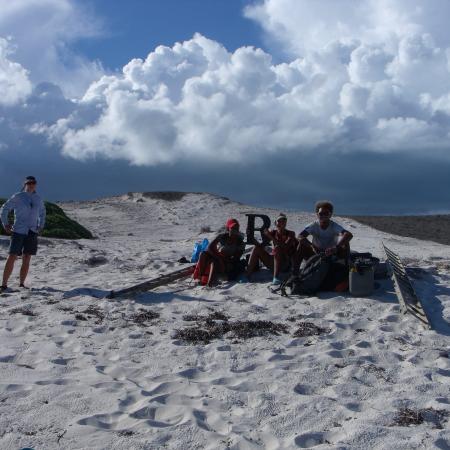
As SIF’s Project Officer and ACUP’s co-team leader I help steer a project that benefits Aldabra, Seychelles and the international community. ACUP's scale and multiplicity has improved my knowledge and its aims add to the global movement of #beatplasticpollution and it shares Aldabra with people who would otherwise never visit such a wonder. Through social media, corporate and crowd funding ACUP unites people globally to tackle one of the collective problems of our time and I am proud to be part of it.
My experience of Aldabra changed my life and led me to this solution. When financial constraints forced the deferral of my studies I spent seven months working on Aldabra. While there I learned of Aldabra’s global significance and the major threats encroaching upon the atoll. One of these, marine pollution, was as shocking as it was obvious. Counting turtle tracks on Aldabra's remote nesting beaches showed me the scale of the issue. Often as staff we talked about this and concluded that the main challenge was finance. Removing such waste form Aldabra would exceed the funds available to manage Aldabra and thus it looked like an intractable issue. I remember thinking how could somewhere so remote and protected be hurt by daily human items? And how could we make a difference? December 2013 I left Aldabra to study and though incredible, my experience left me feeling that some environmental issues were unsolvable.
After my studies I returned to SIF and was granted another chance to help solve this problem. I was moved by global and local actions on this issue, and the role of youth, so jumped at this chance. ACUP's initial phase involved meetings with people I had never met and led to brainstorming sessions on attracting the right finance. In doing so we found that the right platform needed public and private participation. Working at ACUP’s confluences is an amazing learning experience, and seeing environment and business collaborating is promising in a world increasingly portrayed as a zero-sum game. This is especially true for an avid International Relations student and working conservationist who aims to take on other issues such as climate change. Seeing the ACUP team’s friends, family, as well as strangers fund and convince businesses to finance a solution emboldens me to believe that international cooperation can solve global problems.

